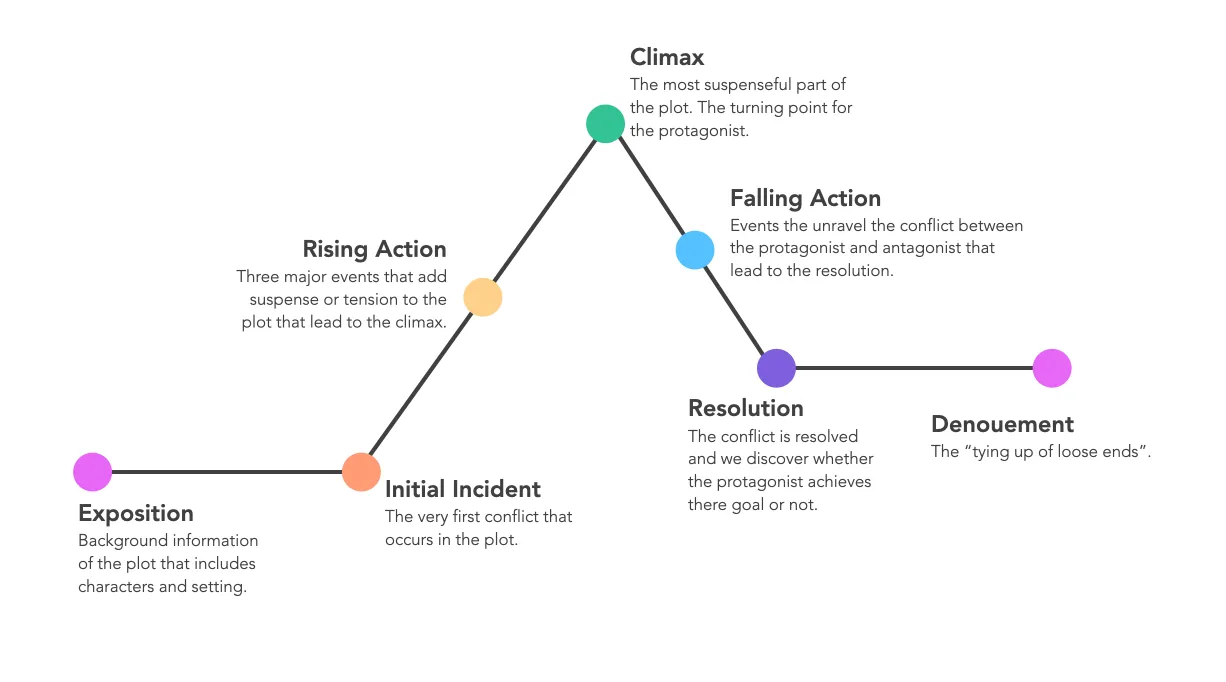
Storytelling is an art form. But like most things, it can be taught – the basics can be at least. It all starts with a formula. It’s called the Story Arc.
We all learned this in elementary school. Does conflict, setting, and plot ring a bell? You might be surprised that there is a process to storytelling. This is one of those moments where school and the real-world come full circle. So how does this apply to advertising?
If you happen to have read our blog on Unleashing the Power of Storytelling you’d know that it has EVERYTHING to do with marketing.
The blueprint that provided the foundation for your dreaded summer reading is just as applicable in the world of marketing. The common theme is that in every ad campaign, every blog, every social media post, a story is told. When you sell a product or service, you are selling the story behind it.
Let’s walk through the steps.

Step 1: Elements of story
Define the characters
When we say characters, what we’re really talking about are the personas representative of the consumers you are trying to sell to, and there are many characters all of which are highly nuanced. They have unique histories, goals, relationships, wants, needs, challenges, etc. Take a homeowner for example. The homeowner has a history of maintaining or improving their home and has the goal of spending time there with the ones they love the most, their family. These are very common attributes of homeowners. As marketers, we are tasked with honing in on the most common attributes of our most likely customers and creating characters that people can relate to. This allows us to speak directly to a specific person or group of people.
Create the backdrop
The situation your character is faced with is just as important as the actual character. People are widely defined by the setting they find themselves in and the choices they make, and so are our characters. The location, time of year, weather etc. affects things characters do and why they do them.
For example, if the setting was in Minnesota during the winter when the lakes are frozen over, it would be a great opportunity to tell a story about ice fishing or the dangers of lake accidents in the winter. See how the setting provides the stage for the story? In Phoenix, Arizona, during the late summer, temperature breaking heat waves and monsoons descend on the Valley, causing any number of problems. Which brings us to…
Challenge
You can have characters and a setting, but need conflict to make a story engaging and memorable. Think about it. No one wants to hear a story about how everything went according to plan. Because what’s the point?
For example, let’s say Johnny drives to the store and he finds everything he was looking for and then he goes home. Good for Johnny, but nobody really cares. Instead, what if Johnny gets to the store and he’s in a crowded parking lot looking for a space. He sees someone leaving, so he puts his blinker on and waits patiently for the car in front of him to back out of the parking space. After the car clears the spot, he begins pulling in, when whoosh! From the opposite direction Susie swiftly cranks the wheel and reems her way into the briefly open space.What will happen between Johnny and Susie? We all want to know what happens next. Conflict is engaging!
Using the example of monsoons, the conflict in that situation could be between a homeowner, a roof in disrepair and a nasty monsoon. The monsoon crashes down and the roof starts to leak water into the house. What will the homeowner do first to resolve this? We must communicate the challenges our buyers have so that we can position our solution as the next logical step.
Plot
Spoiler alert! You will be the hero in your own story and save the day. But before you get there you need a beginning and a middle. Assuming the story is about a person, we’ll need to know what their situation was prior to the conflict and resolution. It can be shown overtly or be implied, but a starting point must be included.
Taking the example of the homeowner with a leaking roof, we can assume that before the monsoon all was well with the roof –or at least the homeowner was oblivious to any problem. Then the monsoon strikes and water starts leaking through the roof. The homeowner notices the leak and is forced to act, but he doesn’t know how to fix a roof. Enter American Roofing and Waterproofing! Here to save the day and solve the problem. The homeowner went from bliss, to horror, to sunshine and rainbows. In your story, the rainbows could be real or implied, just as long you provide a wanted or needed solution to a problem.
Step 2: Finding the story
Purpose
The sole purpose of telling a story is to get people to buy. So what i will pull people into making that buying decision? Your options? Entertain, educate, inspire, or persuade. The idea is that people are more likely to buy your product or service if you say more about your company, brand, and mission. Anyone in any industry has a solution that works. How can you set yours apart so that you’re not exactly like everyone else? Start by telling a story of meaning rather than a story of tactical use. When you make people laugh, they won’t want to miss the next thing you say. They will be listening and interested, and pay attention when you say, “go online to get your FREE estimate.”
Draw from the buyer’s experience
It all comes back to the buyer. Be honest with who they are and what they need. What is generally true about your customers? Do they have families, lead active lifestyles, or spend a lot of time at nightclubs? You must be able to infuse these types of elements into your characters in order to make them seem whole.
If people see themselves represented in your story, they’ll see what your product can do for them.
Take the homeowner example from earlier. We know that many homeowners have families, so when we tell the story of the monsoon and water leaking through the roof, we can show how that might affect the homeowner’s children. The message that a leaky roof will impact the entire family, including the homeowner’s children can be powerful and urge someone to buy.
Step 3: Don’t write a book, tell your story through video
Impact
The impact of video cannot be understated in its ability to communicate complex messages in a short amount of time, thus leaving an impact on consumers. They say a picture is worth 1000 words, but what about 24 frames (or more) per second in a video? That’s 24,000 words in one second!
Video combines visuals, audio, and motion to create a powerful and immersive storytelling experience. It is, without a doubt, the best way to tell a story that engages consumers quickly and emotionally. It’s especially important that we are able to be brief with consumers given short attention spans and the sheer amount of content thrown at everyone daily. The ability of video to emit emotion allows consumers to feel the emotion and connect. It’s not explained, it’s experienced.
Video is boundless in that you get to put people right where you want them to be. Whether you want people to feel like they’re on a beach in sunny San Diego, CA, or in the middle of a snow storm in the Antarctic. With video you’re able to provide an immersive experience that communicates your message clearly and concisely. According to Hubspot 71% of people think positively about brands that publish videos!
Reach
Use video to meet people where they are online. The internet is filled with videos and people are watching them like crazy! 82% of the content being consumed online today is video according to Cisco.
There are so many channels to reach your audience online and social media is ripe for dispersing your message. Let’s say you create a video commercial to play on live T.V. You can now repurpose that video to publish on Instagram, Facebook, LinkedIn, Pinterest, YouTube etc. This way you reach a more modern audience – if that’s where your customers are. By using video storytelling, companies can adapt to the preferences and habits of contemporary viewers. Anywhere your customers are, you’ll want to meet them there with video.
Social media is great since so many people are watching videos AND sharing them. Social video generates 1200% more shares than text and images combined, according to LinkedIn. With social, you have access to metrics and insights through views, likes, shares, and comments. Knowing this, reaching people with video on the internet should be top of mind.
As you combine the right elements to form your story, represent your buyers in that story, and use the right tools to share your story, you’ll see more traffic, leads and sales.
Telling your story powerfully is important, and getting it right can be tricky. Knoodle has experts that can help you develop ideas, strategy, and tactics to tell your story better and get more business.
Reach out to us to chat about ideas for your specific industry and business.
Or Call (602) 530-9900